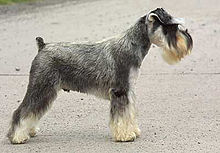Miniature Schnauzer
The Miniature Schnauzer is a breed of small dog of the Schnauzer type that originated in Germany in the mid-to-late 19th century. Miniature Schnauzers developed from crosses between the Standard Schnauzer and one or more smaller breeds such as the Poodle and Affenpinscher, as farmers bred a small dog that was an efficient ratting dog. They are described as "spunky"[1] but aloof dogs, with good guarding tendencies without some guard dog's predisposition to bite. Miniature Schnauzers are recognized in three colors internationally: solid black, black and silver, and a color known as 'salt and pepper'. There is a controversial fourth color variant in Miniature Schnauzers, pure white, which is not recognized universally.
The breed remains one of the most popular world wide, primarily for its temperament and relatively small size. As of 2008 it is the 11th most popular breed in the U.S.[2]
History
The earliest records surrounding development of the Standard Schnauzer in Germany come from the late 19th century. They were originally bred to be medium-sized farm dogs in Germany, equally suited to ratting, herding, and guarding property.[1] As time passed, farmers bred the Standard Schnauzer into a smaller, more compact size for ratting by combining it with the Affenpinscher and Miniature Poodle.[1][3] The first recorded Miniature Schnauzer appeared in 1888, and the first exhibition was held in 1899.[3][4]
The AKC accepted registration of the new breed in 1926, two years after Miniature Schnauzers were introduced to the United States.[5][4] They were originally known as Wirehaired Pinschers.[6] Although they are recognized internationally with the Schnauzer and Giant Schnauzer in the Working group, in the AKC the Miniature Schnauzer is classed with the terriers.[4] It was recognized by the United Kennel Club in 1948 and also classed as a terrier.[7] The start of the modern Miniature Schnauzer is generally considered to begin with Ch. Dorem Display, the first Miniature Schnauzer to win Best in Show at the Westminster Kennel Club Dog Show.[8] He was born 5 April 1945 and lived to be nearly fourteen.[8] Almost every living Miniature Schnauzer in America can trace their lineage back to Dorem Display.[8]
Description
Appearance
Miniature Schnauzers have a squarely proportioned build, measuring 13 to 14 inches (33 to 36 cm) tall and weighing 10 to 15 pounds (4.5 to 6.8 kg) for females and 11 to 18 pounds (5.0 to 8.2 kg) for males.[1] They have a double coat. The exterior fur is wiry and the undercoat is soft. The coat is kept short on the body, but the hair on ears, legs, and belly are retained. Recognized coat colors are black, salt and pepper, black and silver, and pure white.[9]
Miniature Schnauzers are often described as non-shedding dogs, and while this is not entirely true, their shedding is minimal and generally unnoticeable. They are characterized by a rectangular head with bushy beard, mustache and eyebrows; teeth that meet in a "scissor bite"; oval and dark colored eyes; and v-shaped, natural forward-folding ears (when cropped, the ears point straight upward and come to a sharp point). Their tails are naturally thin and short, and may be docked (where permitted). They will also have very straight, rigid front legs, and feet that are short and round (so-called "cat feet") with thick, black pads.[5][10]
North American white Schnauzer controversy
The white Schnauzer is one of four color varieties of the Miniature Schnauzer currently recognized by the World Canine Organization. However, they are not accepted for conformation showing by the American Kennel Club and Canadian Kennel Club.[11] The controversy rests on the disputed origins of the white variation: whether it was contained within the genes of the originally recognized breed, or whether it was the result of subsequent modifications. Since the other two Schnauzer types have never been available in a white variation, and the original German standard never included white as an acceptable color, the AKC chooses not to recognize white dogs.[12]
Temperament
The American Kennel Club breed standard describes temperament as "alert and spirited, yet obedient to command... friendly, intelligent and willing to please... never overaggressive or timid."[5] Usually easy to train, they tend to be excellent watchdogs with a good territorial instinct, but more inclined toward barking than biting. They are often aloof with strangers until the owners of the home welcome the guest, upon which they are typically very friendly to them.[13]
They are highly playful dogs, and, if not given the outlet required for their energy, they can become bored and invent their own "fun". Miniature Schnauzers can compete in dog agility trials,obedience, showmanship, flyball, and tracking. Schnauzers have a high prey drive, which means they may attack other small pets such as birds, snakes, and rodents. Many will also attack cats, but this may be curbed with training, or if the dog is raised with cats.[5]
 | ||||||||||||||||||||||||||||
| Classic pose of a Miniature Schnauzer. This dog has a natural (stripped) salt and pepper coat, natural ears and docked tail. | ||||||||||||||||||||||||||||
| Other names | Zwergschnauzer (Dwarf Schnauzer) | |||||||||||||||||||||||||||
|---|---|---|---|---|---|---|---|---|---|---|---|---|---|---|---|---|---|---|---|---|---|---|---|---|---|---|---|---|
| Country of origin | Germany | |||||||||||||||||||||||||||
| ||||||||||||||||||||||||||||
| ||||||||||||||||||||||||||||



No comments:
Post a Comment